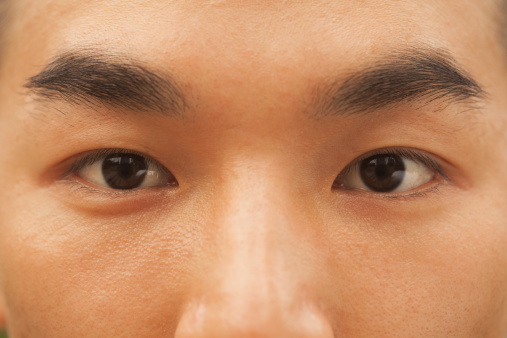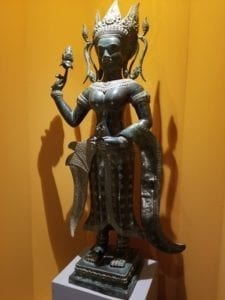Foreigners of all colors call it rude, uncivilized and violating- but they miss the point entirely. We all stare at the Other.
 I am chuckling as I read my umpteenth blog written by a foreigner about the Chinese love for staring. The Chinese have allegedly taken staring, especially at foreigners, to a high art form and it seems to disturb a lot of people, even the so-called open minded. After spilling out a tally of stare incidents one blogger (I will keep them all anonymous) writes “If the Chinese would smile while they’re staring I’d probably start a conversation, but instead they choose to stare at me like I’m a giant freak”. Another cannot refrain from extolling the belief that their homeland is a multicultural nation of great tolerance and acceptance- a civilized place where staring at people is completely unacceptable.
I am chuckling as I read my umpteenth blog written by a foreigner about the Chinese love for staring. The Chinese have allegedly taken staring, especially at foreigners, to a high art form and it seems to disturb a lot of people, even the so-called open minded. After spilling out a tally of stare incidents one blogger (I will keep them all anonymous) writes “If the Chinese would smile while they’re staring I’d probably start a conversation, but instead they choose to stare at me like I’m a giant freak”. Another cannot refrain from extolling the belief that their homeland is a multicultural nation of great tolerance and acceptance- a civilized place where staring at people is completely unacceptable.
“I know… I know… it is Chinese way” writes another, “but sometimes… I just want to scream at them……“Just Stop Staring at us”. I am stared at like a caged animal at the zoo, and it is enough to make any sane person feel as though they were.” Another blogger posted a photo of a Chinese woman who was staring at her family with the caption “So here she is, Ms. Orange Jacket, who could not mind her manners and instead STARED AT MY KIDS LIKE A STUNNED BUNNY FOR TEN MINUTES STRAIGHT. This has won her a spot here in this next Revenge Photo, where you can now pretend to stare at her unabashedly for as long as you’d like.”
An African American mother was disturbed that people wanted to touch her children’s hair constantly and a blond Australian woman became petrified when a man came to her taxi window and was so transfixed he froze two inches from the glass and did not respond to her banging and screaming. A belligerent young man demanded that he be ‘respected’ and called those staring at him names that I dare not repeat.
Foreigners of all colors call it rude, uncivilized and violating- but they miss the point entirely. We all stare at the Other.
“Staring, in its pure and simple essence, is the time required by the brain to make sense of the unexpected,” explains Jeanne McDermott, the mother of a child born with Apert Syndrome, a congenital disorder characterized by malformations of the skull, face, hands and feet. Ms. McDermott does not need to visit China to understand staring. She knows staring is a powerful and vivid way of expressing our response to others.
Dr. Rosemarie Garland-Thomson from Emory University writes:
Staring starkly registers intense interest and endows it with meaning. That interest ranges widely in form–from domination, adoration, curiosity, surprise, allegiance, disgust, wonder, befuddlement, openness, hostility, to reverence. The stare is a highly charged interpersonal encounter that we snap up in a variety of contexts to put a sharp point on what we mean, think, or want. Staring is a way of strongly reacting to another; it bespeaks involvement. It is the human response to novelty, to the unexpected.
As such, staring is an embodied and relational visual exchange that carries complex cultural and historical meanings. Like sex and eating, staring is drenched with significances, scrupulously regulated, and intricately ritualized. Civility, for example, has always strictly governed staring and prescribed what we do with our eyes in social encounters. In American culture, the one thing everyone knows about staring is that your mother told you not to do it. Both furtive and compelling, staring is imagined as a formidable interchange and is a source of vivid narrative within in the Western cultural archive. Medusa’s stare turned men to stone; the evil eye haunts pervasively. As ocular-centric modernity developed, myriad institutions lassoed human curiosity by ritualizing the urge to stare at the unexpected. If staring is the effort to make sense of the inexplicable, to craft a narrative of recognition from incoherence, then the target of staring is often that which seems strange or unfamiliar.
During my China visits I have taken thousands of photographs and it is likely that just as many have been taken of me by the Chinese. Yet so far, the intentions behind the constant stares and clicks of a camera are hardly disconcerting. Instead I have hugged and laughed with teen-agers who want to pose with me and have held and kissed dozens of babies and young children whose parents and grandparents giggle in delight as we greet each other with the spare words we know of each other’s language. I do not feel violated when someone stops in the middle of the sidewalk to stare at me. I simply grin back, wave and typically receive an enthusiastic welcome in the form of smiles, clapped hands and repeated calls of ‘Hello, hello, hello, ni hao, ni hao, ni hao !”.
 Google ‘staring’ and you’d think the entire world was paranoid. The complaints are fierce about India, Germany, America, Pakistan, the Middle East, Brazil, Japan, Italy, Uganda and almost everywhere in between. Yet few of the faultfinders bother to examine their own cultures. One Norwegian writer extolled the superiority of his country’s good manners and tolerance for others, all the while groaning about the Chinese. Norway is a fine nation to be sure, yet Norway has its own long history of staring at the ‘Other’.
Google ‘staring’ and you’d think the entire world was paranoid. The complaints are fierce about India, Germany, America, Pakistan, the Middle East, Brazil, Japan, Italy, Uganda and almost everywhere in between. Yet few of the faultfinders bother to examine their own cultures. One Norwegian writer extolled the superiority of his country’s good manners and tolerance for others, all the while groaning about the Chinese. Norway is a fine nation to be sure, yet Norway has its own long history of staring at the ‘Other’.
This was in the news as I was writing: One hundred years ago, Norway opened a human zoo populated by Senegalese villagers living in grass huts, which they strangely named “Congo Village”. In a mere five months this human zoo drew 1.4 million visitors, more than half the country’s population. The Norwegians came to gawk, gaze, google and stare at the cluster of sub-Saharan huts and their inhabitants dressed in traditional garb. The zoo was billed as the celebration of the bicentennial of the signing of Norway’s constitution and its objective was to enthusiastically support colonialism. That was in May, 1914. Now, exactly 100 years later, a replica of the human zoo has returned to Norway through the artistic vision of Lars Cuznor and Mohamed Ali Fadlabi, in the hopes that it will help erase what they say is Norwegians’ collective amnesia about racism. “Norwegians have been propagating this self-image of a post-racial society and it’s been internalized that it’s a good, tolerant society,” Swedish-Canadian Cuznor told Reuters. “It’s great branding and it is self- perpetuating- but it’s a false image.”
Public Art Norway, the government agency that helped with the funding, said the display highlighted questions concerning racism and cultural dominance. “The rebuilding can be regarded as a monument to the collective loss of memory of a shameful part of our history and a platform for discussion of this historical event, contrasting with Norway today,” it stated. Norway’s image for tolerance was tested in 2011 when an anti-immigration gunman killed 77 people in a diatribe against Muslim immigrants and the public’s fear of the “Other” is being tested again in response the return of the “Congo Village”. Like most of the world’s nations, everything has changed in Norway- and nothing has changed. We are all still staring.
A few weeks ago it was a fellow American I met that reiterated the staring complaints. While I huffed my way up 300 stone steps to a temple tucked into the mountains along the Yangtze River, this middle aged tourist told me she would never return to China because she was so offended and repulsed by everyone staring at her. “It feels like they are raping me!” she declared indignantly. I gasped at the boldness of her ignorance. I was too out of breath to speak my mind so I trudged on, leaving her behind. In truth, I’ve always tried to leave women like this behind. She was from the Deep South and whined in a lazy southern drawl, revealing the American ability to deny and forget its own history of violating the “Other”. She has stared plenty herself, I thought in disgust. As I climbed past a majestic Katsura tree spreading huge branches across the path I thought about my own country and how trees were used when women falsely believed a stare from the ‘Other’ was a threat of rape.
Lynching is an American invention. From the mid nineteenth century through half of the twentieth century black men were lynched for crimes real and imagined, for peeping in a window, for whistles, for staring at a white woman. They were lynched from trees in a field, trees on courthouse lawns, from trees used as public billboards, and from streetlamps and telephone poles. More than 200 anti-lynching bills were introduced into the U.S. Congress during the twentieth century- but none of them passed. Author Eula Bliss writes: “Postcards of lynchings were sent out as greetings and warnings until 1908, when the postmaster general declared them unmailable. This is the barbecue we had last night, reads one postcard.” Parents would pack up a picnic, grab their kids and race down to see the action…and you bet these good ole’ folks stared aplenty.
 The blogger who felt she was stared at “like a giant freak” by the Chinese probably does not make the connection to her cultures continued love of freak shows. She has no memory of the construction of disabilities, how non-white “races” were constructed as “inferior,” and the way modern-day “Freak shows” have been resurrected for television. Circuses, side shows and freak shows have a long history in Europe and America and The History Channel’s Wild West Tech calls Freak Shows “The original reality shows.”
The blogger who felt she was stared at “like a giant freak” by the Chinese probably does not make the connection to her cultures continued love of freak shows. She has no memory of the construction of disabilities, how non-white “races” were constructed as “inferior,” and the way modern-day “Freak shows” have been resurrected for television. Circuses, side shows and freak shows have a long history in Europe and America and The History Channel’s Wild West Tech calls Freak Shows “The original reality shows.”
I am not new to staring. I recall moving to the black side of the segregated American South in the 1960’s, where only a rare white person entered and my family stood out like extraterrestrials. Young and old touched my hair and pinched my cheeks for the first few weeks until we were no longer a novelty but simply members of the community. My family took the staring and touching as a code of honor and we never felt violated, choosing instead to empathize with the shock our neighbors must have felt when the moving van arrived.
But I am not in China to give foreigners a history lesson of their cultures. Nor am I here to remind them that the vast majority of the Chinese population regard themselves as belonging to the same race, a glaring contrast to the multiracial composition of other populous countries. China’s population is over 1.351 billion and it is remarkable that most of its population shares this ethnic ‘sameness’. By the end of 2012, there were 633,000 foreign residents in China and this makes China the country with the lowest percentage of foreigners in the world.
Nor am I in China to help foreigners decipher the naturally curious intentions behind the staring they experience. I must let these foreigners live with their own deep seeded insecurities and proud assumptions. No, I am not here to concern myself with stares. I am here to have baijiu drenched banquets; to hear the relentless grind of gears and the blasting of horns as cars weave into crosswalks full of scooters and bicycles; to watch the generation of Chinese Great Gatsby’s prance in Gianni Versace shoes; to smell the garland of musty sweat, smog and urine drifting from the streets; to feel the summer heat descend like an electric blanket; to explore the boom towns and the silent waters of the olive rivers; to awe at the window washers dangling from a skyscraper by a single rope; to listen to the gaggle of grandparents chucking peas on a stoop; to eat hongshu, duck heads, flying lizards and seahorses; to ride a scooter through a cacophony of traffic; to gaze at stony grey skies; to laugh with old men pushing mahjong tiles atop park benches; to dance until dawn; to partake in animated conversations in six languages; to savor the silence of the temples; to speak deeply with inquisitive and intelligent youth; to hold hands with new friends; to hoot, yelp and holler in joy; and to embrace the beauty and camaraderie of a wondrous and ancient land.
You can stare all you want to China. It is just fine by me.
The Stare, first published in Ningbo Guide- one of only 6 independent magazines in China
May 2014 – Jinx


